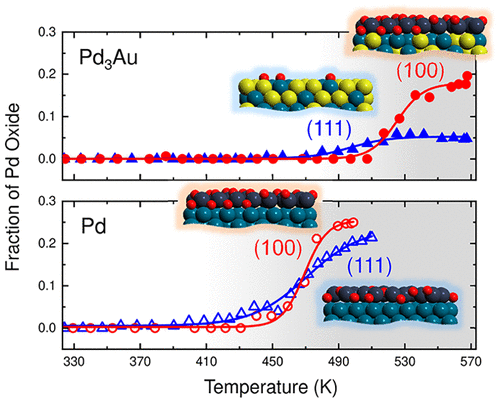当前位置:
X-MOL 学术
›
J. Phys. Chem. Lett.
›
论文详情
Our official English website, www.x-mol.net, welcomes your
feedback! (Note: you will need to create a separate account there.)
Orientation-Dependent Hindrance to the Oxidation of Pd–Au Alloy Surfaces
The Journal of Physical Chemistry Letters ( IF 4.8 ) Pub Date : 2020-10-19 , DOI: 10.1021/acs.jpclett.0c02645 Ryo Toyoshima 1 , Kenta Amemiya 2, 3 , Kazuhiko Mase 2, 3 , Hiroshi Kondoh 1, 2
The Journal of Physical Chemistry Letters ( IF 4.8 ) Pub Date : 2020-10-19 , DOI: 10.1021/acs.jpclett.0c02645 Ryo Toyoshima 1 , Kenta Amemiya 2, 3 , Kazuhiko Mase 2, 3 , Hiroshi Kondoh 1, 2
Affiliation

|
Oxidation of monometallic Pd and bimetallic Pd3Au alloy surfaces are observed by in situ ambient-pressure X-ray photoelectron spectroscopy (AP-XPS) at an elevated pressure (100 mTorr O2 ambient). It is directly evidenced that the alloying with Au hinders the surface oxidation of Pd3Au surfaces compared with monometallic Pd surfaces. Remarkably, the oxidation behavior is clearly different between Pd3Au(111) and (100) surfaces. The (100) surface has a relatively Pd-rich surface composition, and the surface oxide layer is formed, whereas the (111) surface has a Au-rich composition, and the surface oxidation is quite limited. A combined approach of experimental and theoretical techniques reveals that Pd/Au surface composition and atomic arrangement are key factors determining the oxidation behavior.
中文翻译:

Pd-Au合金表面氧化的取向依赖性阻碍
通过在升高的压力(100 mTorr O 2环境)下的原位环境压力X射线光电子能谱(AP-XPS)观察到单金属Pd和双金属Pd 3 Au合金表面的氧化。直接证明与单金属Pd表面相比,与Au的合金化阻碍了Pd 3 Au表面的表面氧化。值得注意的是,Pd 3之间的氧化行为明显不同Au(111)和(100)表面。(100)表面具有相对富Pd的表面组成,并且形成了表面氧化物层,而(111)表面具有富Au的组成,并且表面氧化受到很大限制。实验和理论技术的组合方法表明,Pd / Au表面组成和原子排列是决定氧化行为的关键因素。
更新日期:2020-11-06
中文翻译:

Pd-Au合金表面氧化的取向依赖性阻碍
通过在升高的压力(100 mTorr O 2环境)下的原位环境压力X射线光电子能谱(AP-XPS)观察到单金属Pd和双金属Pd 3 Au合金表面的氧化。直接证明与单金属Pd表面相比,与Au的合金化阻碍了Pd 3 Au表面的表面氧化。值得注意的是,Pd 3之间的氧化行为明显不同Au(111)和(100)表面。(100)表面具有相对富Pd的表面组成,并且形成了表面氧化物层,而(111)表面具有富Au的组成,并且表面氧化受到很大限制。实验和理论技术的组合方法表明,Pd / Au表面组成和原子排列是决定氧化行为的关键因素。











































 京公网安备 11010802027423号
京公网安备 11010802027423号